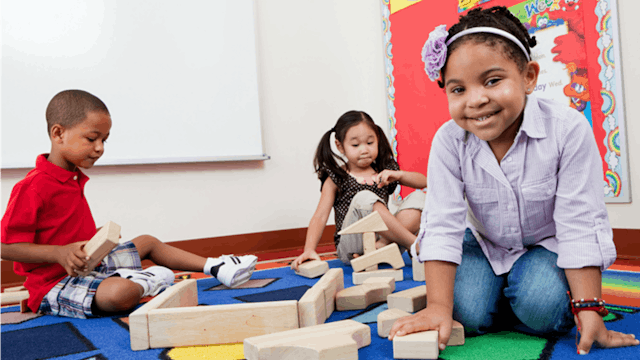Boston Public Schools Are Making A Big Shift, And Here's Why It Matters

My younger son started kindergarten this year, and while he’s had a great year so far, there has been one aspect that has continually bugged me. “There is so much WORK!” he tells me periodically.
When I ask him what he means, he complains of sitting at his desk, doing worksheets, and feeling bored and restless. And yeah, it breaks my heart a little when I hear him say that.
Don’t get me wrong. His teacher is a wonderful, caring, thoughtful person who infuses plenty of play and creativity into the kids’ days. They are probably only spending 20% of the day glued to their desks, and even then, I know she makes it fun and interesting. I also know she is just following the protocol that she’s been instructed to implement.
After all, these same kids will be taking standardized tests in just three years, and damn it to hell if their preparation doesn’t start now, at the ripe age of 5 (sarcasm definitely intended here).
But it’s sad to me, because I just don’t think young children should be spending more than a few minutes a day sitting at a desk working. Really, they’ve got the rest of their lives to do that.
More educators are realizing this as well. Over the past decade, school has become more and more academic—and at earlier ages. But I fear it’s not doing much besides making kids impatient and turning them against learning at young ages. Research shows that the best way to get kids interested in learning at those early ages is not to plop a couple of worksheets in front of them, but to get them learning through play.
After all, play is what young children are best at, right? Why not harness that into something educational?
Well, Boston Public Schools, one of the largest school systems in the country, is doing just that. In February, they announced—both in a post on their Facebook page and via an article on WBUR.org—a shift toward more play-based learning initiatives in their early childhood programs.
The district, which encompasses 56,000 students and 125 schools, is trying to strike a balance between letting their young students “just be kids,” while also preparing them for the academic expectations that lie ahead for them (i.e., standardized *groan* tests).
“What we’ve done in Boston is really think about how do you rewrite a curriculum that will support what we know about young children,” Jason Sachs, Boston Public Schools’ director of early childhood education, tells WBUR. “But also get them to a place they can be ready in third grade for the MCAS test and other learning in general.”
So how are they going about this?
According to WBUR, it’s through learning activities like the ones in Miss Kelly Stevens’ kindergarten class in East Boston. In her classroom, kids are divided into small groups, and are assigned “learning stations.” There are no worksheets, and the kids are active.
Activities they might participate in include one described by WBUR, where students construct a wolf statue with blocks. Next, their job is to label the body parts of the wolf, working together to figure out how to label and spell each work (“ear,” “nose,” “eye,” etc.).
Awesome. The kids get to play, use their hands, bodies, and their imaginations—while also honing their literacy skills. Don’t you just love it?
Miss Stevens admits to WBUR that switching from more regimented work to something like this took some getting used to. But now that she’s seen the results, she’s sold.
“I used to be very regimented and structured,” said Stevens. “I didn’t like the blocks. Because it was messy and it was loud.”
After implementing these changes in her classroom, Stevens is definitely seeing the positive impact it’s had on her students, both socially and academically.
“I see significant changes in their oral language development at the kindergarten level,” said Stevens.
As for these new district-wide changes making an overall impact on the students, it’s too soon to tell, but researchers from the University of Michigan, Harvard and MDRC will be studying the shifts by following a group of kindergarteners for three years to study the outcomes.
I look forward to what they find, but my guess is that the shift toward play-based learning is going to have a pretty amazing effect on these kids—and one that we should all be paying attention to.
And regardless of what kind of learning system is best for kids from an academic point of view, I think that most parents know in their guts that 5- and 6-year-old kids thrive best when they are playing and active. It’s what they are meant to do—and it’s what we all remember spending most of our early childhood education years doing.
Our kids only get one chance to be kids, and we need to care take to keep their beautiful, creative spirits intact as much as possible.